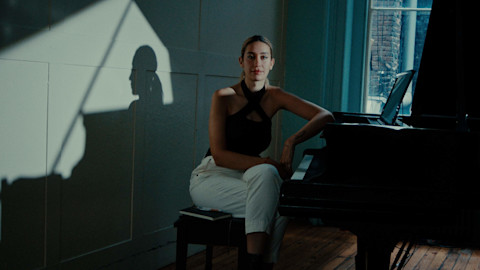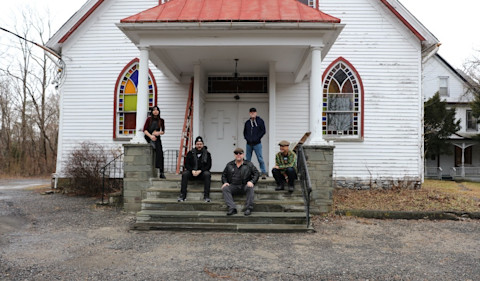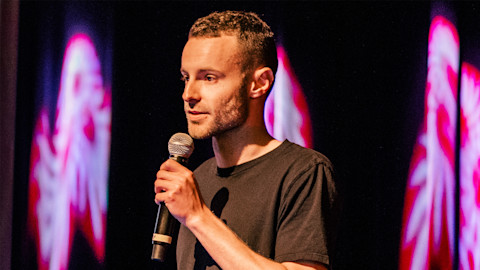How artists are taking their fans into virtual worlds on a budget, and how you can follow.
Slip on a headset, wait a moment in the dark, and then you find yourself in a place previously reserved for a select few — on-stage next to Paul McCartney in front of thousands of screaming fans. For many artists, it seems like a dream on every level — but in reality, at least one part of it is eminently achievable. While they might never play guitar or drum for the former Beatle (who teamed with Jaunt VR for a series of videos), they can at least give their fans the same experience, letting them be immersed in a 360° world. While these types of experiences were previously reserved for superstars with the attendant budgets, recent advances in technology mean that even the scrappiest band can create compelling virtual or augmented reality content.
(Scenes from Craig Wedren's Adult Desires VR App, Courtesy of Craig Wedren)
Craig Wedren, who led the rock band Shudder to Think and now performs as a solo artist and composes music for films (including the recent Netflix original A Futile and Stupid Gesture), recently released a Virtual Reality companion app alongside his new album, Adult Desires.
“I originally started playing with VR in 2011, and wanted to do something for my last solo album, but the technology wasn’t quite there yet,” he says. “This time around, it was much easier — I got an affordable 360° camera and started filming. I shot a lot of home movies, and they took on a surreal and dreamlike quality because of the intimacy of the medium.” Once the footage was edited, he built the app so it would all be randomized, and no user would ever have the same experience twice. The result is that the viewer is deeply immersed in Wedren’s home life, and even the most mundane things — a cactus in the backyard, his son brushing his teeth — take on an over-the-top quality.
(Scenes from Craig Wedren's Adult Desires VR App, Courtesy of Craig Wedren)
“Even small gestures come across as very grand in VR,” Wedren says. “Doing something very simple can still be very dynamic and shocking. I think about all the bands I loved as a kid and how much I wished I could hang out with them on tour, for example. A band could easily take a 360° camera on the road and shoot cinema verite style, and fans would really get a lot out of it.”
Matthew Celia of Light Sail VR
Creating a simple and intimate experience for fans was the goal of Robert Watts and Matt Celia, who run Light Sail VR and worked with the indie-bluegrass band Abby & The Myth. “We’ve been working on a show called #ConcertForOne which is basically an adapted version of MTV Unplugged optimized for VR,” says Watts. “The idea is to record an all acoustic performance of bands playing in a cool space and leveraging the power of spatial audio and performance to make it feel like you are witnessing a private concert just for you.”
Watts adds that for artists, sound is absolutely crucial, even if they are on a tight budget. “You don’t need a huge budget to make a 360° music video, you just need to set realistic expectations about the experience you want to deliver to your fans. If you know most of your fans are going to watch your content on Facebook, don’t bother with the expense of 3D or added interactivity. Focus instead on a great sound mix,” he says.
For the indie band Golden Suits, director Jason Koffeman, who had previously directed VR pieces for fashion brand Marco Marco, was forced to work creatively within the limits of a tiny budget and came up with an innovative solution for the video for their song “Don’t Let Love Go By.” He recruited several dancers and had them create a scenario where the user felt like they were moving with them throughout the experience. It was fairly simple to shoot, but Koffeman says the result is “an expressive, 360 dance video where the viewer moves with the dancers that really raises the stakes and puts you inside the emotions."
(Director Jason Koffeman, behind the scenes of the Golden Suits video)
For artists worried that not enough of their fans will have access to VR headsets or want to watch a 360° video, augmented reality offers another path forward. While there isn’t as much augmented reality content on the market due to the fact that many platforms used to create it are relatively new, it does offer a lower barrier to entry — almost everyone has a smartphone that can be used to view and interact with the content.
David Lobser and Scott Garner of Object Normal have worked on several music experiences, including an AR experience for the band Health. They point to tools like Unity, a game engine, as being key to helping smaller artists take the plunge into new realities.
“Broadly speaking, the same tools that helped democratize game development can now be used for all kinds of media,” says Garner. “The most exciting thing about working in this space for us, though, is the new kinds of music-based experiences these tools and platforms can offer. Rather than just passively consuming the content, viewers and listeners can actively participate through shared virtual concert experiences, interactive narrative experiences or even by authoring their own creations.” And while building in Unity is still a little too complicated for many artists, more developers are learning the language, and willing to work with bands for discounted fees.
Aside from finding developer partners willing to work on the cheap, bands interested in space can dive in by buying a 360° camera and just shooting content. A decent camera can now be had for a few hundred dollars, and the cost of the software to stitch together the content is also falling as the software improves. From there, the sky is the limit — you just have to make sure what you’re shooting works in 360. But as long as the user has a reason to interact with the content, you’re most of the way there. In a few years, immersive content will probably be the norm, as AR continues to grow and VR headsets get lighter, cheaper, and better. Now is the perfect time for bands to start experimenting with the medium and drawing fans in.
—Cortney Harding
Popular Stories
video
How Julia Wolf Made It




